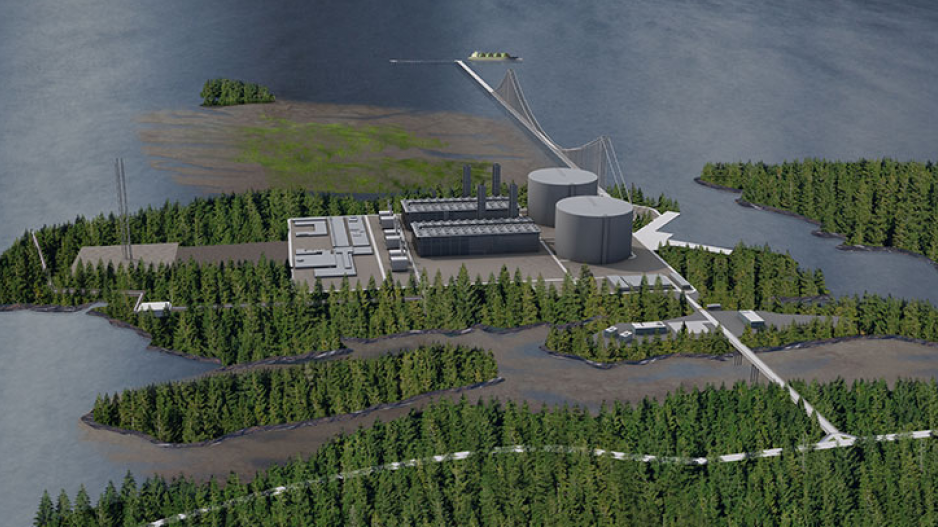PNW LNG spokesman Spencer Sproule said the company is reviewing the project, but would not confirm the company is specifically looking at Ridley Island for a terminal site.
"Pacific NorthWest LNG is conducting a total project review over the coming months," he said in an email. "During this time, the project is continuing to work with area First Nations, stakeholders, and regulators, to manage any potential impacts through mitigation measures and design optimization."
The $11 billion liquefied natural gas (LNG) project in Prince Rupert has been plagued by delays and controversy, partly due to the site Petronas chose.
The PNW LNG proposal calls for an LNG plant to be built on Lelu Island, with the liquefied natural gas being piped to a terminal off Flora Bank, via a suspension bridge.
Flora Bank is ecologically sensitive. Flora Bank's eelgrass beds are important salmon habitat, and the project has been vigorously opposed by local Tsimshian First Nations. Some First Nations have occupied Lelu Island with a protest camp.
Citing anonymous sources, Bloomberg has reported that Petronas is now considering moving the export terminal to a site on nearby Ridley Island, which is managed by the Prince Rupert Port Authority.
That site only became available when Canpotex Ltd. abandoned its plans in June to build a new potash export terminal on Ridley Island.
Colin Coe, an energy consultant specializing in LNG projects, says the rumour that Petronas was considering an alternative site has been making the rounds in the industry for a while now.
Moving the export terminal away from Flora Bank to Ridley Island would make some sense, he said, although it would likely require going back to the drawing board with respect to the environmental permitting the project has already completed.
Building a suspension bridge across Flora Bank would be expensive. It is estimated that locating the export terminal on Ridley Island could save the company about a $1 billion, if it did not have to build the suspension bridge across Flora Bank.
“It’s probably prudent that they looked at it,” Coe said.
However, he added it’s no easy task to switch sites, once all the engineering is done and environmental permitting obtained.
“Sometimes companies move in and chose a site and they’re kind of locked and loaded to go through that process, and once you start your work on a specific site it’s not a trivial matter to move that site,” Coe said. “It’s a big job to go through and change the site.”
But with oil and gas prices depressing Asian LNG prices, it makes sense to try to get the project’s capital costs down, and choosing a site that does not require a $1 billion suspension bridge might go some way in accomplishing that.
When LNG projects were first proposed for B.C., there was some urgency in getting them approved and built, since the companies were in a race to lock up long-term offtake agreements with Asian buyers.
But those projects missed the last window, and there is now an oversupply of LNG on the market, thanks in part to new LNG projects now in production in Australia. The demand for LNG in Asia has also slowed somewhat.
Analysts now predict the next wave of demand for LNG in Asia will occur between 2025 and 2030. It takes about four to five years to build an LNG plant and associated pipelines, which is why some experts do not expect to see final investment decisions on any large LNG projects until around 2018 or 2019.
Natural Gas Minister Rich Coleman is still optimistic that Petronas will take a final investment decision in 2017 on its PNW LNG project.
In a year-end statement, he said the province estimates $20 billion has already been invested in B.C. to build a nascent LNG industry. Petronas alone, through Progress Energy, has been spending roughly $2 billion a year in B.C., Coleman said.
“That proposal could be finalized in 2017,” Coleman said.




